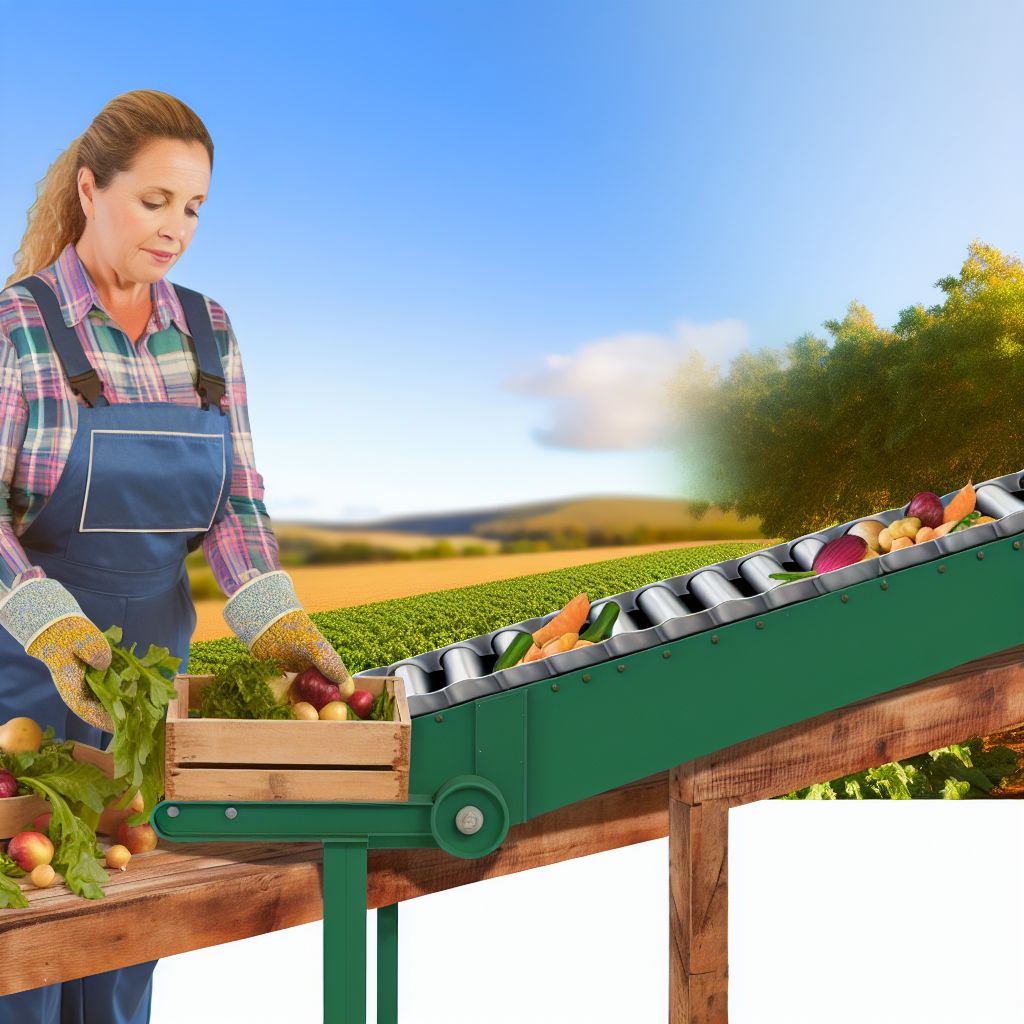Overview of Farm-To-Table Laws and Their Importance
Farm-to-table laws focus on creating direct connections between farmers and consumers.
These laws aim to promote local agriculture and sustainable practices.
By reducing the distance food travels, they support the local economy.
Farmers benefit from increased sales and customer relationships.
Consumers enjoy fresher food with enhanced nutritional value.
Moreover, these laws help reduce carbon footprints associated with transportation.
Overall, farm-to-table initiatives encourage healthy eating habits.
They also raise awareness about food origins and production methods.
Consequently, consumers become more informed about their choices.
Farm-to-table laws thus play a vital role in shaping food systems.
The Role of Community Support
Community involvement is crucial for the success of farm-to-table initiatives.
Local organizations often provide resources and support to farmers.
This includes training on sustainable practices and marketing strategies.
Partnerships with local businesses can strengthen distribution networks.
Farmers’ markets showcase local produce and foster community spirit.
Transform Your Agribusiness
Unlock your farm's potential with expert advice tailored to your needs. Get actionable steps that drive real results.
Get StartedSuch events encourage direct interaction between producers and consumers.
Additionally, schools can integrate local food into their menus.
This promotes healthy eating habits among children and families.
Health Benefits of Fresh Foods
Fresh foods contain higher levels of vitamins and minerals.
They also lack preservatives found in processed items.
As a result, consuming fresh produce can improve overall health.
Furthermore, a diet rich in fruits and vegetables reduces chronic disease risks.
Farm-to-table laws encourage these dietary changes by promoting accessibility.
Eating locally also supports healthier food choices, improving community wellness.
Environmental Impact
Farm-to-table laws significantly contribute to environmental sustainability.
By shortening food supply chains, they reduce energy use and waste.
Local sourcing minimizes packaging and associated environmental costs.
Additionally, these initiatives support local biodiversity.
Sustainable farming practices protect soil health and water resources.
Consequently, communities benefit from cleaner ecosystems.
Key Regulatory Challenges Faced by Agricultural Producers
Understanding Farm-To-Table Laws
Farm-to-table laws promote direct sales between farmers and consumers.
However, these regulations can vary widely by locality.
Producers face confusion due to differing requirements.
Thus, navigating this landscape becomes complex for farmers.
Licensing and Permits
Many agricultural producers require various licenses to operate.
These can include food safety, health department, and agricultural permits.
Obtaining these permits often involves lengthy processes.
Additionally, some producers may find it hard to meet changing regulations.
This can result in delays and increased operational costs.
Showcase Your Farming Business
Publish your professional farming services profile on our blog for a one-time fee of $200 and reach a dedicated audience of farmers and agribusiness owners.
Publish Your ProfileFood Safety Regulations
Food safety is a critical concern in farm-to-table sales.
Producers must comply with strict safety standards.
Regulations often require regular inspections and audits.
Farmers may need to invest in new technologies to ensure compliance.
For example, tracking systems can enhance transparency in food sourcing.
Insurance Requirements
Liability insurance is essential for producers selling directly to consumers.
However, determining the appropriate coverage can be challenging.
Producers may not fully understand the types of coverage needed.
As a result, they may face unexpected liabilities or costs.
Market Access and Distribution Issues
While farm-to-table initiatives aim to reduce distribution barriers, challenges remain.
Producers often struggle to access local markets effectively.
Transportation costs can limit their ability to reach consumers.
Moreover, competition with larger distributors poses additional challenges.
The Complexity of Labeling Requirements
Labeling laws are critical for consumer trust and transparency.
However, these laws can be intricate and vary by region.
Producers must ensure their products meet all labeling requirements.
This includes accurate information on ingredients and sourcing.
Failing to comply can result in penalties and product recalls.
Building Community Support
Community acceptance is vital for successful farm-to-table initiatives.
Producers often rely on local connections to thrive.
Therefore, fostering good community relationships helps in overcoming regulatory challenges.
Farmers can engage with local organizations to raise awareness.
Collaboration can lead to more support and understanding within communities.
The Role of Consumer Demand in Influencing Farm-To-Table Legislation
Understanding Consumer Preferences
Consumer preferences shape local food policies significantly.
People increasingly desire fresh, locally-sourced ingredients.
This demand encourages farmers to adopt farm-to-table practices.
The Impact of Awareness Campaigns
Awareness campaigns play a crucial role in consumer education.
These campaigns inform consumers about the benefits of local food systems.
As a result, more people become supportive of farm-to-table initiatives.
Shifts in Purchasing Behavior
Recent years have seen a noticeable shift in purchasing behavior.
Consumers are now willing to pay more for locally-produced goods.
This willingness increases pressure on policymakers to support farm-to-table legislation.
Challenges in Meeting Consumer Demand
However, farmers face challenges in scaling up their operations.
Supply chain complexities often hinder local producers.
In addition, compliance with regulations can be burdensome.
The Role of Restaurants and Local Businesses
Restaurants and local businesses serve as mediators in this context.
They can highlight local producers through menus and promotions.
Thus, they help raise awareness about farm-to-table options.
Future Trends and Considerations
As consumer demand evolves, so must farming practices.
Innovative farming techniques can meet the needs of health-conscious consumers.
Showcase Your Farming Business
Publish your professional farming services profile on our blog for a one-time fee of $200 and reach a dedicated audience of farmers and agribusiness owners.
Publish Your ProfileFurthermore, transparent sourcing offers trust and builds loyalty.
Delve into the Subject: Leveraging Import Export Policies For Agricultural Growth
Economic Implications for Small vs. Large Agricultural Producers
Impact on Small Agricultural Producers
Small producers often face unique challenges when implementing farm-to-table laws.
Increased compliance costs can strain their limited financial resources.
These costs include new packaging, labeling, and transportation expenses.
Consequently, many small producers may struggle to remain profitable.
Moreover, they might lack access to the necessary technology for compliance.
As a result, they may find it difficult to compete with larger producers.
Small producers typically depend on local markets for their revenue.
Thus, any changes in regulations can significantly impact their sales.
To adapt, many small producers need additional training and support.
Community programs can help bridge these gaps effectively.
Effects on Large Agricultural Producers
Large agricultural producers have different resources at their disposal.
They generally possess greater capital for compliance adaptations.
This financial ease allows them to absorb increased costs more effectively.
Consequently, they may view farm-to-table laws as a competitive advantage.
Large producers can invest in technology solutions for efficient compliance.
As a result, they can maintain or even enhance profit margins.
However, they still face market pressure to meet consumer demands for local sourcing.
Failure to adapt to new expectations can harm their brand reputation.
Additionally, they must also consider the logistics of supply chain management.
Finding local suppliers that meet quality standards can be challenging.
Comparative Advantages and Disadvantages
Both small and large producers experience distinct benefits and drawbacks.
Small producers often enjoy the ability to build close relationships with consumers.
This connection can enhance customer loyalty and brand strength.
On the other hand, large producers benefit from economies of scale.
They can distribute costs over larger volumes, allowing for competitive pricing.
However, small producers may react more quickly to market changes.
This agility allows them to meet niche demands effectively.
In contrast, large producers might struggle with bureaucracy and rigid structures.
Ultimately, both groups must navigate regulatory challenges thoughtfully.
Supportive policies can help level the playing field for all producers.
Delve into the Subject: Choosing Between Crop Insurance and Comprehensive Farm Insurance
Logistical Issues in Supply Chain Management for Fresh Produce
Understanding Supply Chain Dynamics
Supply chain management affects the farm-to-table process significantly.
Fresh produce requires timely delivery to maintain quality.
Producers need to understand each link in the supply chain.
Additionally, they must respond promptly to changes in demand.
Transportation Challenges
Transportation plays a crucial role in getting produce to markets.
Farmers often face delays due to traffic or mechanical issues.
Moreover, weather conditions can disrupt transportation schedules.
Showcase Your Farming Business
Publish your professional farming services profile on our blog for a one-time fee of $200 and reach a dedicated audience of farmers and agribusiness owners.
Publish Your ProfileThese delays may result in spoiled goods and reduced profit margins.
Storage and Handling Issues
Proper storage is essential for maintaining the freshness of produce.
Many farms lack adequate cold storage facilities on-site.
This leads to an increased risk of spoilage during transport.
Handling practices also impact the quality of fresh produce.
Inadequate training can result in damage during packing.
Coordination Among Stakeholders
Effective communication among all stakeholders is vital.
Farmers, distributors, and retailers must share crucial information.
Insufficient coordination can lead to mismatches in supply and demand.
Systems must be in place to facilitate real-time updates.
Regulatory Compliance
Farmers must comply with numerous regulations affecting logistics.
This includes standards for food safety and handling procedures.
Failure to meet these requirements can result in penalties.
Producers must stay informed about changing regulations.
Adaptation to Market Trends
Market trends continually evolve, affecting supply chains.
Farmers need to adapt quickly to changing consumer preferences.
For instance, a shift toward organic produce requires different practices.
Producers must be proactive in addressing these market dynamics.
Technology Utilization
Technology can substantially enhance supply chain efficiency.
Farmers can use software for tracking inventory and deliveries.
Additionally, automated systems can reduce human errors.
Investing in technology may pose initial challenges, but it’s beneficial long-term.
Building Resilience
Building a resilient supply chain is crucial for producers.
This includes diversifying suppliers and distribution channels.
Producers should also create contingency plans for disruptions.
Resilience helps maintain operations during unforeseen events.
Gain More Insights: Benefits of Comprehensive Crop Insurance for Modern Farms

Compliance Costs and Resources Required for Agricultural Producers
Financial Implications
Implementing farm-to-table laws incurs significant financial costs.
Producers face expenses for sourcing local ingredients.
Additionally, compliance requires investments in infrastructure.
Producers must also contend with potential fines and penalties.
Overall, these costs can strain their financial resources.
Labor Requirements
Compliance with farm-to-table regulations demands increased labor.
Producers need extra hands for sorting and quality control.
Moreover, training staff on new regulations is essential.
This often leads to higher labor costs for producers.
Finding qualified workers can also present challenges.
Supply Chain Adjustments
Producers must adapt their supply chain to meet regulations.
They need to establish relationships with local suppliers.
Moreover, ensuring consistency in product quality is critical.
Showcase Your Farming Business
Publish your professional farming services profile on our blog for a one-time fee of $200 and reach a dedicated audience of farmers and agribusiness owners.
Publish Your ProfileProducers may also face delays in sourcing local ingredients.
Such delays can disrupt their operations and planning.
Resource Allocation
Allocating resources effectively is crucial for compliance.
Producers must balance between traditional farming and new requirements.
This can lead to tensions regarding resource prioritization.
Furthermore, disruptions in cash flow may occur during transitions.
Overall, effective resource management is essential for success.
Regulatory Knowledge
Producers need a thorough understanding of local laws.
Navigating regulations can be complex and time-consuming.
Additionally, staying aware of changing laws is vital.
Producers often require legal advice to ensure compliance.
This adds another layer of cost and resource commitment.
Uncover the Details: Adopting Food Safety Standards to Improve Farm Profitability
Impact of Local vs. State Regulations on Farm-To-Table Efforts
Understanding the Regulatory Landscape
Farm-to-table initiatives face challenges due to varying regulations.
Local and state laws can significantly influence agricultural practices.
Farmers often juggle different compliance requirements from different authorities.
The Role of Local Regulations
Local regulations can promote fresh produce consumption.
They often support farmers’ markets and community-supported agriculture.
However, these rules may also impose strict operational requirements.
Consequently, small producers may struggle to comply.
The Influence of State Regulations
State regulations typically offer a broader regulatory framework.
They aim to standardize practices across larger areas.
This approach can provide consistency for producers.
On the flip side, state-level regulations may overlook local needs.
Balancing Local and State Needs
Finding a balance between local and state regulations is crucial.
Collaborative efforts can yield legislation that addresses both levels.
Farmers can benefit from a unified set of guidelines.
This consolidation may enhance compliance while promoting local food systems.
Challenges in Implementation
Conflicting regulations often lead to confusion among producers.
Farmers may find it difficult to navigate multiple layers of regulations.
This complexity can deter new entrants into the farm-to-table market.
As a result, small farms may face a competitive disadvantage.
Youth and Community Engagement
Community involvement is essential for successful farm-to-table initiatives.
Engaging youth through educational programs fosters interest in local agriculture.
Local governments can play a pivotal role by promoting such initiatives.
Awareness and support can create a stronger farm-to-table ecosystem.
Strategies for Overcoming Implementation Challenges
Building Strong Partnerships
Collaboration among stakeholders enhances the farm-to-table movement.
Producers should connect with local chefs and restaurants.
This partnership fosters mutual benefits and increased visibility.
Additionally, forming alliances with community organizations strengthens outreach.
Showcase Your Farming Business
Publish your professional farming services profile on our blog for a one-time fee of $200 and reach a dedicated audience of farmers and agribusiness owners.
Publish Your ProfileSharing resources among producers promotes efficiency and innovation.
Utilizing Technology for Efficiency
Technology adoption streamlines farm-to-table operations significantly.
Producers can use farm management software to track yields and costs.
Online platforms facilitate direct sales from producers to consumers.
Social media engagement helps build a loyal customer base.
Moreover, innovative delivery systems reduce transportation time and costs.
Educating Farmers and Consumers
Education is key to overcoming implementation barriers.
Workshops on compliance with farm-to-table laws empower producers.
Additionally, consumer education raises awareness about local food systems.
Schools can integrate farm-to-table concepts into their curricula.
This approach nurtures a new generation of informed eaters.
Ensuring Accessibility for All
Accessibility is crucial for the success of farm-to-table initiatives.
Producers should explore diverse distribution methods to reach consumers.
Farmers’ markets offer an excellent venue for direct sales.
Community-supported agriculture (CSA) programs provide weekly subscription options.
Furthermore, incentive programs can help low-income families access fresh produce.
Implementing Sustainable Practices
Adopting sustainable practices strengthens farm-to-table offerings.
Producers should employ organic farming methods whenever possible.
Crop rotation and permaculture enhance soil health and biodiversity.
This commitment to sustainability attracts environmentally-conscious consumers.
As a result, sales can increase through a dedicated customer base.
Additional Resources
Farmers Employ Strategies To Reduce Risk of Drought Damages …




